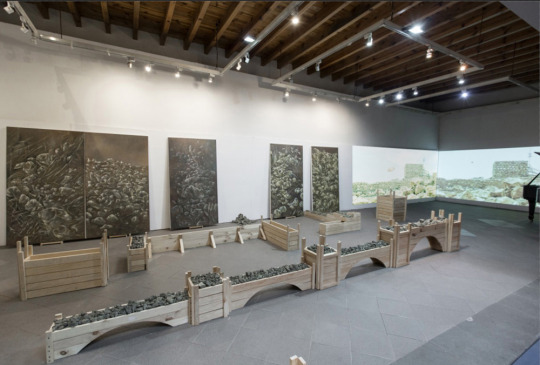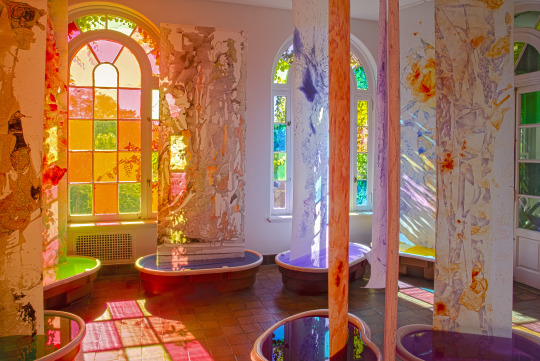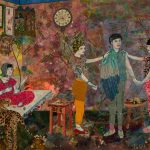Conversations | Keren Anavy, Israeli Artist and IAP Alumna
“I see collaboration as another way of making art and developing as an artist in a broader community.“
Keren Anavy is an Israeli painter, installation artist, and alumna of NYFA’s 2017 Immigrant Artist Mentoring Program. Her work explores the dynamic relationships between nature, culture, and site. Anavy is interested in how cultivated landscape, as well as wild nature, can function as cultural agents in Eastern and Western societies. For her recent exhibition at the Sunroom Project Space in Wave Hill, she created an immersive installation.
On March 10, 2019, Utopia, a new interdisciplinary work and Anavy’s collaboration with choreographer Valerie Green, will be performed by Valery Green/Dance Entropy at Pioneer Works.
NYFA: Can you tell us about your collaboration projects in Mexico and New York, including the upcoming Utopia at Pioneer Works?
Keren Anavy: Alongside my work as an individual artist, I have developed two significant collaborations in recent years. Utopia is a collaboration with Valerie Green/Dance Entropy based in Queens. Choreographed by Valerie Green with original music by Mark Katsaounis, the evening-length work explores the idea of a perfect place through dance and visual art. The piece questions whether Utopia is an internal place, investigated through personal and intimate moments and alongside the community.
I turned my large-scale paintings into 10-foot cylindrical pillars to be used throughout the performance. The original paintings were exhibited at my solo show, Garden of Living Images, at the Sunroom Project Space in Wave Hill (2018), which references Chinese scrolls and the fabled Hanging Gardens of Babylon. The pillars act as an extension of the internal world, constantly forming barriers, spaces, and other environments for the dancers to both react to and orchestrate. The notion of what it means to be safe persists inside a dynamic art installation which is in perpetual motion, being constantly built and dismantled. Utopia challenges the viewer’s conception of how art, dance, and design interact with and influence one another. Utopia has been shown at Danspace Project, St. Mark’s Church, New York and at the Queens Museum, among others, and is going to be performed at Pioneer Works’ Second Sundays on March 10.
My second collaboration is an established ongoing collaboration for the past eight years with Tal Frank, Israeli born sculptor, currently based in Mexico City. Our research-based projects explore the dynamic relationship between nature and culture through the lens of specific sites and locations. Our recent exhibition, Compositions for Stones of Gold (2018), supported by Asylum Arts’ New York grant, was a site-specific installation in a historic building in Mexico City. We investigated archaeological sites of water-related structures such as aqueducts and ruins both in Mexico and Israel in order to scrutinize the relationship between place, nature, and identity. We’ve had exhibitions in Mexico and Israel as well as a formative experience at the Everglades National Park residency in Florida (AIRIE Program), where we further perfected our work process dynamics for a month at the reserve.

NYFA: You are an alumna of NYFA’s Immigrant Artist Mentoring Program (IAP): Visual Arts. How did participating in this program help your career?
KA: First and foremost it allowed me to be part of a valuable community of international artists who care about each other and are willing to share ideas and contribute from their knowledge and experience. The possibility of being in dialogue with additional practitioners about career development strategies as an artist helped me to grow professionally.
I greatly appreciated the feedback I received during some of the meetings with the mentors and mentees. I deeply benefitted from these conversations. Learning from the experience of the whole community of artists (mentees and mentors), originally from many different places, showed me various career paths to learn from and provided me with confidence and lots of inspiration.
NYFA: How do you find opportunities and resources?
KA: There are social media accounts, of course, and newsletters from wonderful organizations such as NYFA (the best!), Residency Unlimited, Res Artis, and many more, but this is basic in order to get to know the field. I think an artist should focus on places that are relevant to their concepts and practice, research them in depth, and learn what they have to offer specifically. Another great resource is the resumes of artists you admire and who are interested in issues similar to yours. It is a great way to discover programs and places that can be relevant for you.

NYFA: Any advice to immigrant artists living in NYC who are interested in collaborations?
KA: Residency programs are a good place to start developing connections with different art professionals and to establish future collaborations and projects. I really believe in the residency framework and I think it’s a format that gives a significant anchor to an immigrant artist in an artistic metropolitan area like New York. The programs are very different from one another, I suggest that artists explore the existing programs and try to find one that fits their character, practice, and artistic goals. Research is one of the most important things and if you can visit the program in open studio days, I highly recommend it. It helps to feel the vibe of the place, and it’s also fun as an artist to be from time to time on the other side. I learned a lot from these events. In general, in New York, there are many open studios events in studio buildings (not limited to residency programs). Visiting them can be very rewarding since in a relatively short time you can see a lot of artists with different approaches and connect after the event with potential collaborators and with those who have similar interest.
See as much art as you can and be open-minded about other mediums. Visit venues that show multidisciplinary art, for example, BRIC, Flux Factory, Pioneer Works, The Kitchen, and many more. Also, visit non-profit art organizations that focus on a particular medium or specific technique (print, textile, etc) and that you might have the interest to collaborate with. Last (but which actually needs to be first in order of priority) are my favorites, the most friendly and important for your development as an artist in a community, the artist-run galleries.
Utopia will be performed at Pioneer Works’ Second Sundays on March 10, 8:00 PM – 9:00 PM.
This interview is part of the ConEdison Immigrant Artist Program Newsletter #114. Subscribe to this free monthly e-mail for artist’s features, opportunities, and events.
Images from Top: Keren Anavy in collaboration with Valerie Green/Dance Entropy, Utopia, 2018, documentation of performance at Danspace Project, St. Mark’s Church, New York, Photo Credit: Stephan Delas Heras; Keren Anavy in collaboration with Tal Frank, Compositions for Stones of Gold, 2018, installation view, site-specific installation, The Gallery of the Cultural Institute Mexico-Israel, Mexico City, oil on linen, wood, Pyrite stones, video animation screening, Photo credit: Zony Maya, Keren Anavy, Garden of Living Images, 2018, (detail), site-specific installation, Wave Hill, Sunroom Project Space, ink and colored pencils on transparent Mylar, polyethylene ponds full of water with ink, vinyl cover the windows, Photo credit: Stefan Hagen, courtesy of the artist and Wave Hill






